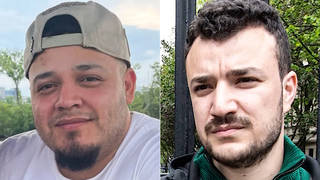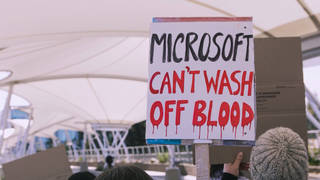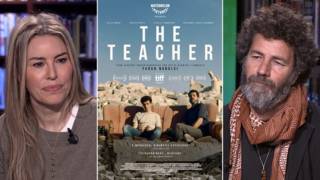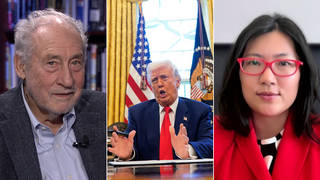
With the eyes of the nation firmly focused on the devastation of Hurricane Katrina, there have been major developments in the battle over the future of the Supreme Court with the death of Chief Justice William Rehnquist and President Bush’s decision to nominate John Roberts to replace him. We speak with Bruce Shapiro of The Nation and Michael Ratner of the Center for Constitutional Rights. [includes rush transcript]
With the eyes of the nation firmly focused on the devastation of Hurricane Katrina, there have been major developments in the battle over the future of the Supreme Court. Last weekend, the ailing Chief Justice, William Rehnquist, passed away leaving a vacancy at the helm of one of the 3 branches of the government.
President Bush moved quickly in naming his desired replacement for Rehnquist: Judge John Roberts–the man Bush had already selected to fill Sandra Day O’Connor’s seat. The 50-year-old Roberts had been set to face Senators this week in what was expected to be a highly confrontational confirmation hearing. Senators have just postponed that process. The Supreme Court now has two vacancies giving President Bush major power to shape its political composition for decades to come.
- Bruce Shapiro, contributing editor for The Nation and a national correspondent for Salon.com.
- Michael Ratner, president of the Center for Constitutional Rights.
Transcript
AMY GOODMAN: We’re joined now from a studio at Yale University Bruce Shapiro, contributing editor for The Nation Magazine and national correspondent for Salon.com and we’re joined by Michael Ratner, President of The Center for Constitutional Rights. Bruce, let’s begin with you. Can you talk about the significance of the deaths of Judge Rehnquist, his legacy, and then we’ll talk about Judge Roberts?
BRUCE SHAPIRO: Well, I think it’s safe to say that no one, not even Ronald Reagan, has had the kind of influence over the Constitution, certainly no conservative had the kind of influence over the Constitution that William Rehnquist has had. His career which begins as a young law clerk opposing Brown vs. The Board of Education when he was a clerk to Judge Robert Jackson and extends all the way up through, you know, Bush vs. Gore and all the way up through the last few years. His career really embodies the sort of abiding concerns of the right. The concerns with the demand to roll back civil rights. The insistence on freeing the market of new deal regulation and social legislation. The concern for reducing the role of the federal judiciary and advancing states rights. All of those are at the heart of the Rehnquist mission. Criminal law, the death penalty, Rehnquist was at the middle both as a lawyer in his early years opposing participation of African-Americans in Arizona, later as assistant attorney general in the Nixon administration, promoting political surveillance, wiretapping. And then finally as a justice where he was a key voice, the pivotal voice in turning back civil rights and civil liberties the last 25 years. It’s a remarkable career. It’s a important legacy for the right and one I think that president Bush hopes to continue with the nomination of Judge Roberts.
AMY GOODMAN: Bruce Shapiro, we’ve been focusing a lot, of course, as the whole world has, certainly this country has, on New Orleans. What about a case from there, Plessy vs. Ferguson?
BRUCE SHAPIRO: This is an important part of New Orleans history which collides with the biography of Chief Justice Rehnquist. In 1892 a group of African-American community leaders and Creole community leaders in New Orleans decided to challenge the new Jim Crow laws; the segregation laws. A man named Homer Plessy tried to buy a ticket as a test case on the Louisiana railroad out of New Orleans. He was told he had to sit in the blacks only car. He wouldn’t. He was arrested. And out of that came the great test case which the Supreme Court at that time used to validate segregation. One of the great black marks really in American history. The moment that “Separate but Equal” became the law of New Orleans, the law of Louisiana. The law of the land. Well, you fast forward some six decades. This young law clerk William Rehnquist is sitting in the chambers of Judge Jackson. He is clerking for him. Brown versus board of education is being argued out before the court in its early phases. This is 1952. And young William Rehnquist takes it upon himself to write a memo, a now notorious memo arguing to Judge Jackson that Plessy vs. Ferguson, the doctrine of “Separate but Equal” was correctly decided and should be upheld that Brown vs. Board of Education and desegregation should be turned back. Well, many years later Judge Rehnquist claimed he wrote that memo only at the request of Judge Jackson. Most of Jackson’s biographers and historians dispute that, they point out that Jackson voted in favor of Brown, that he favored desegregation of the schools. And there is no doubt that throughout his career Chief Justice Rehnquist had an abiding concern with turning the court away, from defending minority rights, and from turning the court away from enforcing the legacy of Brown vs. Board of Education. I think you can see it playing out in the streets of New Orleans today, in the Astrodome in Houston, in the faces of the refugees, the legacy of Separate but Equal, the legacy of Plessy vs. Ferguson. And I think it’s really a black mark against Judge Rehnquist’s jurisprudence that he was never one to consider the social consequences of the conservative legal theories that he championed.
AMY GOODMAN: Bruce Shapiro, what about his practice before he was not only the Justice, Chief Supreme Court Justice and Judge on the Supreme Court but his time in Arizona? His history?
BRUCE SHAPIRO: Well, you know, in the 1950’s and early 1960’s, William Rehnquist became a sort of republican activist lawyer in Arizona where he settled. And in that guise, he both opposed the desegregation of restaurants, lobbied against public accommodation ordinances and perhaps most critically he worked as a volunteer republican challenging African-American voters at the polls, trying to get them stricken from voting on the day of the election. This was brought up, revealed in his 1986 confirmation hearing as Chief Justice. It wasn’t enough to derail him. And, yet, it reflects again, and shows the continuity in his career. This was not someone who had some revelatory moment when he turned his back on the legacy of Plessy vs. Ferguson, the legacy of Separate but Equal. This is someone who throughout his career worked hard to limit Brown vs. Board of Education, to limit civil rights laws, to pull the country as far back toward the days of no federal role in advancing civil rights as he could.
AMY GOODMAN: Bruce Shapiro, what about his young law clerk, John Roberts? Now been nominated by president Bush not only to be a member of the Supreme Court with hearings while they were actually set for today. But now with the death of William Rehnquist to replace him as the youngest Supreme Court Chief Justice in what, something like 200 years.
BRUCE SHAPIRO: I think it’s important to understand that Judge Roberts, while unquestionably brilliant and described by his friends as gracious and genial, politically, ideologically, and legally is a true acolyte of Chief Justice Rehnquist. I mean that in a few specific ways. First of all, like Chief Justice Rehnquist, he is not one who believes that federal government has an expansive role enforcing civil rights. In fact, as a young justice department official and more recently he’s argued that congress should be able to limit federal courts enforcement of civil rights laws. That’s crucial. He’s not one to ever turn away from harsh punishment, tough law and order prescriptions. His opinions, his arguments, his writings are replete about that. And I think most critically, very much like his mentor, Judge Roberts is a big defender of expansive power by the executive branch. And particularly the president’s ability to act in the war on terror as he likes in a few weeks ago. Right at the at the same time he was being nominated. Judge Roberts — actually, it was very reminiscent of arguments Rehnquist has made in his youth, well, his younger life argued for Nixon’s invasion of Cambodia, Judge Roberts was one of three Judges to uphold the administration’s military tribunals at Guantanamo Bay to say the Geneva Convention has no — this is beyond the reach of Congress, beyond the reach of courts that is Judge Roberts and in that sense, he really is a true acolyte of Chief Justice Rehnquist who like Chief Justice Rehnquist has never looked back or wavered from his early commitments.
AMY GOODMAN: We’re talking to Bruce Shapiro. He teaches journalism at Yale University and writes for The Nation and salon.com. We’re also joined by Michael Ratner. As Bruce raises the issue of Guantanamo, can you talk specifically about this case that Judge Roberts ruled on and the kind of action you’re taking right now?
MICHAEL RATNER: Well, the case that Bruce is referring to is Hamden v. Rumsfeld. It was a challenge to the military commissions that’s are about to be used at Guantanamo. The central issue in the case is the application of the Geneva Conventions. And the first part is whether a person can even raise that issue. And the second is whether any person at Guantanamo, of course the people in that case Hr. Hamden or any of our clients at the center are protected by fundamental protections of the Geneva Conventions. There are two really, right to a fair trial and the right to humane treatment and to be free from torture that is what was at issue in that case. The case came down as Bruce mentioned 3-0 on part of the issue, having to do with the right to raise the Geneva Conventions issue. But on a key part of the case, whether there were rights under the Geneva convention under what we lawyers call common article three. It was a 2-1 decision with Roberts in the two and there being a concurrence by Williams saying that he believed that the Geneva Convention did provide certain fundamental rights to Guantanamo detainees. Now what’s remarkable to me that case came down on July 19— I’m sorry, the case came down on July 15. It was argued on April 7. On April 1, Judge Roberts met with Alberto Gonzales to discuss the question of his being nominated as a Supreme Court Justice. So a week before the case is argued, he’s meeting with Alberto Gonzales. And over the course of that litigation, before it is decided, he’s met with really everybody in the oval office and the white house. He’s met with the president. He’s met with the vice president, he’s met with various aides, counsel, etc., while the case is pending. Now it seems obvious that here he is counsel in the case didn’t know anything about those meetings. He is sitting on a case that’s central to this administration 's claims for power in the so-called war on terror which is the application of the Geneva conventions. He's meeting with Alberto Gonzales, the very guy that actually is the architect of part much the policies of the Geneva conventions and yet, he says nothing to the lawyers for the Guantanamo detainees, nor does he actually recuse himself from the case. Because of the obvious appearance of impartiality. That is where it stands. And then we have taken some action since then.
AMY GOODMAN: Looking at the meeting, the Hamden case argued on behalf of the administration by a top Gonzales Deputy Assistant Attorney General Peter Keesler and then talking specifically about the people he met with, you mentioned staff, Michael Ratner, vice president Dick Cheney, the vice president’s Chief of Staff Scooter Libby, the white house Chief of Staff Andrew Card, Bush’s top political strategist Karl Rove and the White House Legal Counsel Harriet Meyers and on the date of ruling was issued in favor of the administration, Bush himself conducted the final job interview with John Roberts. Specifically what have you done?
MICHAEL RATNER: Specifically what we did last week is we filed the motion to recuse Judge Roberts from that decision, retroactively, that is to say he should not have taken any part in that decision. And that makes — we did it on behalf of one of our Guantanamo detainees along with another private law firm that is representing him with The Center for Constitutional Rights and we did that saying: this decision not only affects Mr. Hamden but it affects all of our Guantanamo detainees. Because This is the circuit saying that two of the Judges saying there are no rights under the Geneva convention central to the issues of all the Guantanamo bay detainees. And at the time this Judge made that decision, when Judge Roberts made that decision, he should have recused himself according to U.S. Law, a statute that says that appearance of impartiality requires recusal or removal from the case. So we’re asking now that essentially that decision be vacated or just part of that decision be treated as a nullity. We’re arguing the continuation of the Guantanamo Bay cases this Thursday. And in the same court and the question is the court going to feel it’s bound by what Judge Roberts said in that decision? It’s incredible to me. What’s amazing to me is that this hasn’t been a huge stink. We have some people on the judiciary committee, Senator Schumer, Senator Feingold, Senator Lehey saying this is a serious issue. The media hasn’t picked it up. This is amazing. This is a guy getting a job offer, highest job a lawyer can attain really in the United States, a job offer while the central case to the administration is pending. And nothing is being said about it. Nothing was done about it. And so we filed these court papers saying knock this guy off this case.
AMY GOODMAN: And then it would be 1-1.
MICHAEL RATNER: Then it would be — either they would re-argue the whole case or they would assign another Judge or it would be 1-1 and have no precedential value and the issue we’re really concerned about, the application of Geneva, to the Guantanamo detainees.
AMY GOODMAN: Bruce Shapiro, your comment on that and then I want to quickly ask you about Roe vs. Wade and reproduction rights under if Roberts were to be confirmed as Chief Justice, a Roberts court.
BRUCE SHAPIRO: There is no doubt that the Hamden case represents a massive, massive blind spot and should be an ethics scandal for someone about to be appointed as Chief Justice of the United States. What’s crucial in what Michael was saying here to understand is that while, yes, Judges who are getting promoted have to meet with the justice department all the time even though the justice department is bringing cases before them, what makes this different is the stakes on both sides. On the administration’s side, this is a case central to the entire legal strategy for the war on terror. As far as the Bush administration is concerned. And on Roberts’ side, the stakes are just as high. This is for a lifetime appointment to the U.S. Supreme Court. At that time we didn’t know it was going to be Chief Justice. And you have to ask, a reasonable person has to ask, does anyone think that president Bush would have been standing in the Rose Garden introducing Judge Roberts if his opinion had come down the other way? After all of these secret meetings which were not revealed to the lawyers for Hamden. This is an ethics scandal. And I suspect it will make at least some waves in the hearings next week, especially given the new job that Roberts has been proposed for.
AMY GOODMAN: Bruce Shapiro, Roe v. Wade, reproductive rights?
BRUCE SHAPIRO: Well, you know, Chief Justice Rehnquist was one of, at that time, two justices to vote against Roe when it came before the Supreme Court. He voted again, against the reaffirmation of Roe, Planned Parenthood vs. Casey in 1992. We don’t know for sure where Judge Roberts falls on the Roe vs. Wade spectrum. We do know that he is not a Judge that has ever had a kind word so say about privacy rights or addressed the existence of the privacy rights, sexual privacy which lies behind Roe vs. Wade. My guess is that like Chief Justice Rehnquist, he is a bit of a pragmatist on this question much he’s not going to rush to throw Roe vs. Wade and Planned Parenthood vs. Casey, now twice affirmed, out. In his confirmation hearings as a judge, he said this was a well established precedent. What I think we will find is a Chief Justice very friendly to new restrictions to making abortion harder to get, to giving states far more latitude in restricting the availability of reproductive technology and abortion rights. It’s a very important question.
AMY GOODMAN: On that note, I want to thank you both very much for being with us. Bruce Shapiro teaches journalism at Yale University, contributing editor for The Nation Magazine , national correspondent for Salon.com and here in our New York studio at the firehouse, Michael Ratner, President for The Center For Constitutional Rights. This is Democracy Now!.











Media Options